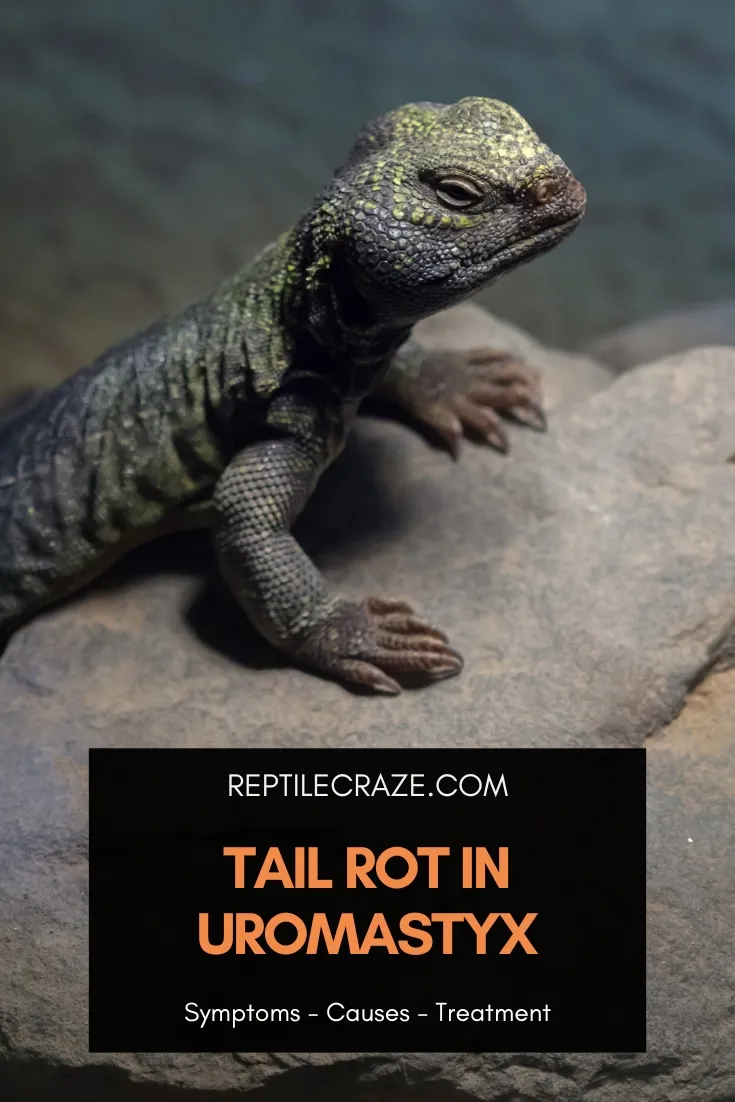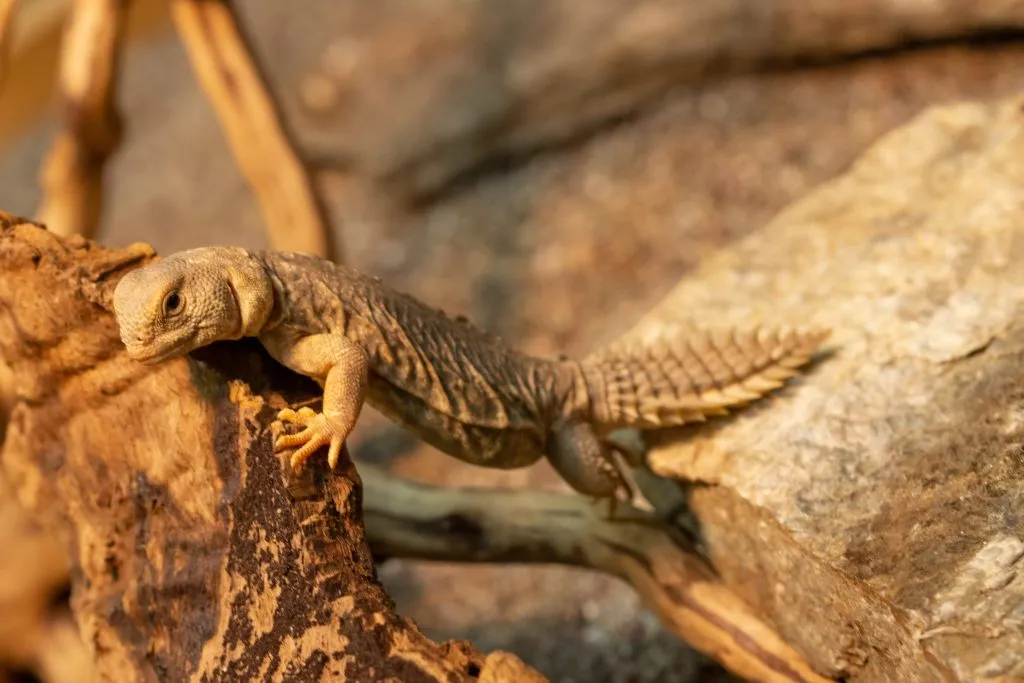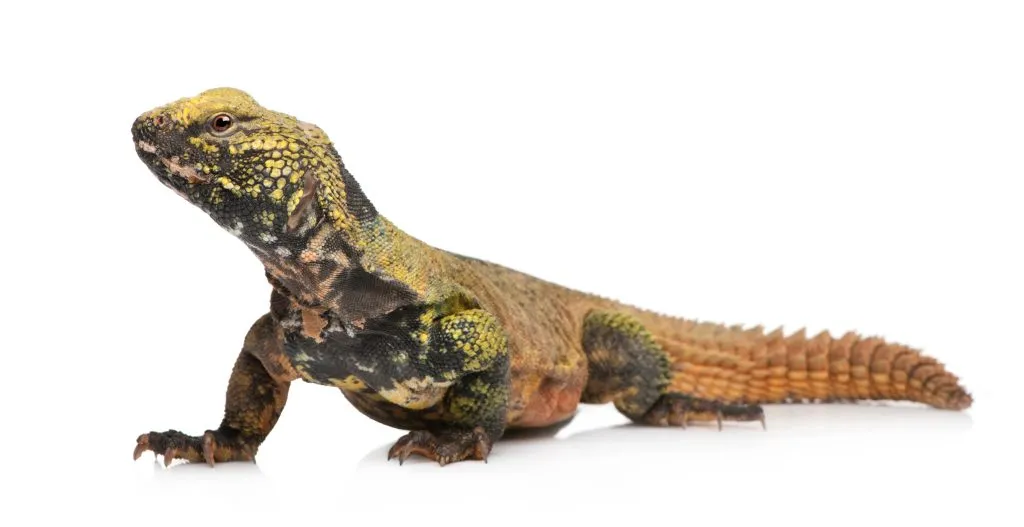
Uromastyx are a popular pet reptile species well-known for their beautiful, spiny tails. However, they are prone to a condition known as tail rot, which can become life-threatening if left untreated. Knowing the symptoms, causes, and treatment is an important skill that uromastyx owners should learn.
Tail rot or tail necrosis in uromastyx occurs due to insufficient blood circulation to the tail, causing tissue death. Infection, improper shedding, trauma, poor nutrition, and improper husbandry are common underlying causes. Early diagnosis and proper veterinary care are necessary for recovery.
In this article, we will explore the symptoms, causes, treatment, and prevention options for Uromastyx tail rot and answer some important questions about this condition.
Table of Contents
What Does Tail Rot Look Like in Uromastyx?
Tail rot in uromastyx is characterized by black or brown discoloration at the affected part of the tail, usually towards the distal end where the blood supply is harder to reach.
A foul odor may sometimes be observed, especially in the presence of an infection.
As the condition progresses, the tail may become swollen, with the skin starting to become brittle, peel, or slough off. In severe cases, the tail becomes fragile and may even fall off, leaving an open wound that becomes prone to further infection.
In many cases, your uromastyx will appear otherwise fine and pain-free. Still, it is good to be on the lookout for other signs of sickness, such as a lack of appetite, lethargy, and becoming sensitive to touch.
Can Tail Rot Be Fatal for Uromastyx?
Yes, tail rot can be fatal for uromastyx if left untreated. The infection can spread rapidly and cause serious damage to the tail and surrounding tissue. Worse, it can even spread into deeper structures such as muscle and bone, causing osteomyelitis.
Uromastyx can die from sepsis, when bacterial infection reaches the blood. Therefore, it is crucial to seek veterinary care as soon as you observe the signs and symptoms of tail rot.
What are the Causes of Tail Rot in Uromastyx?

Dermatitis from Infection
Tail rot can start out as dermatitis caused by bacteria that have invaded the skin. Microorganisms such as Aeromonas and Pseudomonas thrive in warm, moist and unsanitary environments.
This is why it is important to keep your uromastyx’s enclosure clean and dry.
Bacterial dermatitis appears as small blisters or ulcers on the skin. Abscesses with foul-smelling discharge may form before the tissue dies and becomes necrotic.
Although tail rot is not always caused by bacteria, if left untreated, an infection most often complicates the condition.
Improper Shedding (Dysecdysis)
Ecdysis is a normal physiological process among most reptiles wherein they shed off the outermost layer of the skin to grow back a new one.
Unfortunately, incomplete shedding or dysecdysis can sometimes occur, and some skin can become retained around the body and tail.
In uromastyx, the retainment of skin around the tail may impede the blood flow, eventually causing tail rot.
For minor cases, you can gently remove the retained skin off your uromastyx after a warm water soak with this shedding aid solution. But in more severe cases, it is better to consult a herp vet.
Trauma
Long-tailed reptiles like the uromastyx are prone to hitting their tails against objects and enclosure walls. Sometimes, fights can occur between cagemates, resulting in bodily injuries.
These trauma-induced physical damages can cause tail rot, especially during repeated trauma or serious injury.
Poor Nutrition and Husbandry
Are you feeding your uromastyx enough nutritious greens? Do you regularly clean the enclosure and keep the bedding dry? Are humidity, temperature, and lighting kept at optimum levels every day?
Tail rot occurs more frequently when the setup is ideal for bacterial growth, such as in high humidity environment with wet, contaminated bedding.
A cage too small and housing unsuitable cagemates together can predispose your uromastyx to trauma.
How To Treat Tail Rot in Uromastyx?

If you suspect that your Uromastyx has tail rot, it is important to seek veterinary care right away.
Depending on the severity, the vet will administer and prescribe antibiotics and pain medication, remove the necrotic tissue by surgical debridement, or opt to surgically amputate the dead part of the tail.
How Can Tail Rot in Uromastyx Be Prevented?
Tail rot can be avoided by prevention of the common causes mentioned above. Ensuring proper nutrition and improving care and husbandry will protect your uromastyx not just from tail rot, but from a multitude of other reptile diseases.
Some guidelines for the proper care of uromastyx are the following:
Tip: We listed some quick tips below but if you need more help, read our uromastyx care guide here!
- They can be housed individually, in pairs, or in small groups provided that the enclosure is large enough. The cage dimensions should be at least 4 times the length and width of the body.
- If you observe aggression, separate one uromastyx from the other.
- Dirty bedding should be removed daily and thorough cleaning of the
tank should be done monthly. - Keep the basking spot within 100-115F (43-46C). Temperature gradient during the day should be at 90-99F (32-37C), and at night it should be at 70-79F (21-26C).
- Keep humidity levels low, at 15-30%. A thermohygrometer (like this one) is useful in monitoring temperature and humidity in enclosures.
- Provide unfiltered high-output UV lighting for 12-14 hours per day during the spring and summer and 8 hours per day during fall and winter. We recommend this UVB bulb.
- Provide nutritious leafy greens such as kale, romaine, collards, dandelion, lentils, beans, and millet. Adding vitamin supplements weekly to the diet can also be beneficial.
| Husbandry Feature | Description |
| Cage size | Minimum 4 times the length and width of the body |
| Temperature | 100 – 115oF (43 – 46oC) basking spot 90 – 99oF (32 – 37oC) gradient during the day 70 – 79oF (21 – 26oC) gradient during the night |
| Humidity | 15 – 30% |
| UVB Light | 12 – 14 hours per day during the spring and summer 8 hours per day during fall and winter |
- Enchi Ball Python: A Unique and Stunning Morph of Python regius - March 27, 2025
- Emerald Tree Monitor: The Enigmatic Green Guardian of the Rainforest - March 26, 2025
- The Egyptian Cobra (Naja haje): A Fascinating Serpent - March 25, 2025
